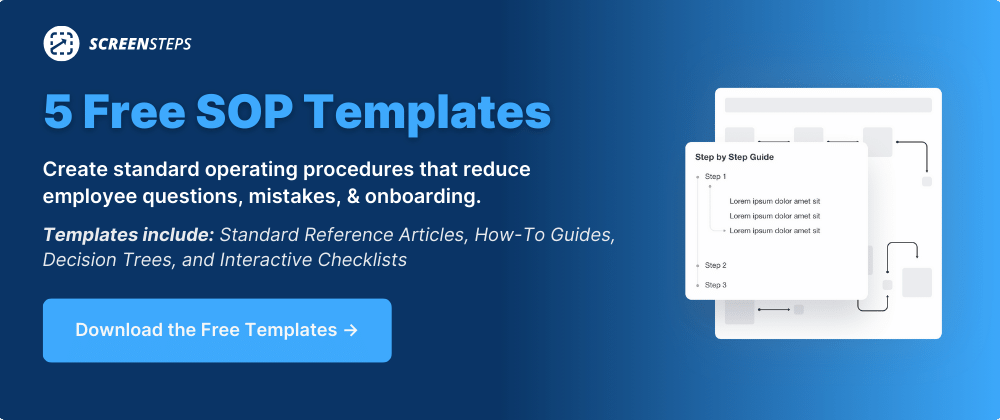How Long Should My Written Company Procedures Be?
When I was younger, I used to think that writing longer stories meant that you were a better writer. And while that might be true for Leo Tolstoy, the rest of us are not legendary Russian novelists.
As a journalist, I learned the power of the inverted pyramid. Answer the 5 W’s and how within the first three paragraphs. AKA: Make it snappy and get to the point.
It’s better for us to get to the point sooner rather than later — and leave out long-winded descriptions about working in the fields (ah-hem, I’m looking at you Levin) — especially when it comes to writing standard operating procedures (SOPs).
Writing procedures for your business can be just as complicated, so you may be tempted to write long, meticulous procedures. You don’t want to miss any vital information.
Working as the Content Marketing Manager at ScreenSteps, a knowledge base software that helps companies clearly create, store, and share procedures, I’ve seen how clearly documented procedures are a game-changer for companies.
For Learning & Development (L&D) content creators, the problem is knowing how long or short your procedures need to be to help employees. This article will help you understand how long your procedures need to be as well as what to include and what to leave out of your procedures.
How long should my written procedures be?
In short, your written procedures should be as long and they need to be and no longer. But what does that actually mean?
When you write your procedures, it can be tempting to include every minute detail so that your employees will have all the information they need to know.
Unfortunately, when you write your procedures using that approach, you crowd the page with text and end up making it more difficult for your employees to follow your instructions.
You’re overpacking your procedures like Mrs. Potato Head as she packed way too much for Mr. Potato Head’s short trip to help rescue Woody.

5 ways to know if your SOPs are long enough or too long
So how do you know if you have written enough to answer the question? If you cover these five points, then you will have an article that is long enough without overwhelming your employees.
1. Understand when your employees will need to use the procedure
Think about the situation in which somebody would be using the procedure you are writing.
Will the person be on a phone call with a customer? Will they need to use this article to answer a question, troubleshoot a problem, or perform a procedure while still talking on the phone? Or can they spend 30 minutes reading it and translating what is written?
This will help you know how much information you should include in your article. If they need to perform a task in real time, you’ll want to condense information so that your employees can move swiftly through a call. Call flows help agents move through these quick-moving tasks.
Whereas, if they have 30 minutes to learn about a task before handling it, you can include more details. You can even include videos in your procedures if your employees are able to review them on their own time (aka: not in front of a customer).

2. Clarify what the employee needs to be able to do
Sometimes as L&D leaders it is easy to forget the intention and focus more on the information. Remember: The point of these procedures is to help an employee accomplish a task, not learn all the ins and outs of it.
You’ll want to understand what the employee needs to do to accomplish the assignment. What job will the employees accomplish after reading this? What behavior is going to happen after completing this procedure?
For this example, you might determine that the reader doesn’t just need to know about purchase orders. You actually need the reader to update a purchase order number on an existing invoice and send the invoice back out to the customer. So you’re going to write that differently.
An article about purchase orders is instructional. It helps the employee build background knowledge. The purpose of the second purchase order example — where they need to update the invoice — requires steps to walk the employee through the process. The writing approach is different including information included and formatting.
3. Leave out background information your employees should already know
Typically, your employees build up knowledge about different products, policies, procedures, and other business operations in training and then over time as they work at their job.
Knowing what general information your employees already know can help you leave out unnecessary background information from your procedures. Most of this general background information is probably taught during onboarding.
In most cases, I assume the reader is familiar with the system and the process in general, so I don’t always need to drop in a lot of background information and context.
Before writing your article, ask yourself: How much do the employees already know? This is the background information you can leave out of your guides.
Some information you could consider leaving out of your procedures include:
- Explanations of why you do a step in a procedure
- Definition explanations
4. Provide a way for readers to learn more about the procedure
But what if not everyone will know the necessary background information?
If you know there might be people reading the procedure who are not familiar with the system or with the overall processes, then you can provide opportunities for employees to learn more about a procedure.
Depending on how you document your procedures — whether that is in Word, PDF, a knowledge base, or another option — there are many other ways for helping employees learn more about procedures.
Using these tools, you avoid muddying up a process with extra information.
Include links
You could include links to other learning assets that explain those things in more detail. Often these links are the background information, such as “What is a purchase order?”
Link to courses
You can create courses that you can link to in the procedures. Employees can open this in another window for when they have more time to learn.
Insert foldable sections
You can insert foldable sections (also called accordion sections or collapsible sections). When you use foldable sections, you can hide the extra information your experienced employees don’t need to read while in the flow of a procedure.
If an employee feels they need more information to complete a procedure, they can open that foldable section to learn more about it within the article.
This option is only included with some web-based knowledge bases.
5. Limit the procedures to vital information
Ask yourself, what is the minimum amount of information the reader needs to be able to do this procedure?
The goal of a procedure is to help employees complete a task — not to ensure they understand at a Ph.D. level the whys and hows of a particular procedure. A procedure’s job is to simply get an employee from Point A to Point B in the minimum amount of time.
When you include too much information, it confuses employees and distracts them from moving onto the next steps. They end up spending too much time reading instead of doing.
Consider an experienced driver test driving a new car. Do they really need to understand what a combustion engine is before they can successfully drive the car? No, they just need to understand how to turn on the car and put it into drive. Then they are out driving the car.
Your guides should include the bare necessities. What is the vital information to complete a task? That could include step-by-step instructions and screenshots of where to click.
How to clearly document your company's procedures
It’s hard to strike a balance between too little and too much information when writing your procedures for your company. You want to provide your employees with just enough information to get the job done without overwhelming them with copy to read.
Our ScreenSteps knowledge base was designed to simplify the content creation. We have a variety of content creation tools that make it easier for you to write procedures that are simple for your employees to follow without missing important information.
Here are three ScreenSteps’ content creation tools that help you write clear procedures that are the right length to answer your employees’ questions.



